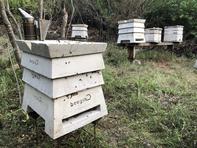When starting beekeeping, a new bee farmer needs a hive. A hive is where the bees will live, raise new bees, keep their egg-laying queen safe and produce honey and other substances for feed.

Bee colonies will also need to be transported (in their hives) from one farm to another for pollination purposes.There are a few ways to buy bee farming equipment in South Africa:
You can start with a used hive, make a hive yourself or buy the loose components and assemble it, which is a big job. Best is to buy a new hive. Most beekeepers in South Africa use the Langstroth hives, which are made of local pine wood. Recently more hives are made from marine plywood, which is more durable than normal plywood.
Concrete beehives and composite plastic hives are alternative options as they are very durable. The plastic beehives are very well designed but expensive.
Used Beehives
Buying second-hand or used beehives may introduce diseases to your colony and it is, therefore, necessary to sterilise a used hive. The used hive components can be treated with corrosive chemicals such as hypochlorite and acetic acid or can be torched or irradiated.
In South Africa, all hives are irradiated or dipped in very hot Waksol or paraffin wax to protect the wood. Take precautions when applying Waksol to the hives. Perhaps ask your local bee-keeping association for guidance.
Best Beehive for Beginners?
A beehive consists of a brood chamber on a base and has 10 wooden frames in the chamber. Each frame has a thin wax strip to assist the bees to start building their wax sheet. On top of the brood chamber, you add a super chamber (with the lid on top) which also includes 10 frames with a small strip of wax. You can have between three and five supers per hive.
Honey is harvested from these superframes. In order to prevent the queen bee from laying eggs in the super, you can place a queen excluder (plastic or metal) between the brood and super chambers. Worker bees - smaller than the queen - can move easily between the grids. Sometimes pollen traps are used at the entrance of hives. These traps collect pollen from bees as they return to the hive. This pollen should be collected daily and frozen to be used later as high-protein supplementary feed for the queen and in times of food scarcity.
Not all bee farmers agree with the use of pollen traps. Some feel it slows nectar collection and the movement of bees into the hive. It is recommended that you place your hive on a stand or bricks – as long as it is off the ground. Not only is it easier on your back when you are working with the hive, but will also help prevent attacks from crawling insects and rodents.
The bee equipment company Bee Ware recommends smearing old motor grease on the stand or bricks to prevent ants from attacking the hive and to not place hives on roofs. Keep the hives in 60% shade during summer.
Where to Buy Beehives in South Africa
If you are looking to buy bee hives in South Africa, you should research where the best quality hives and beekeeping equipment can be bought, talk to other honey farmers or join a local association which may offer advice on the buying of hives.
Also, you may be able to buy hives from experienced beekeepers. In addition, their advice and mentorship are essential for beginners. Buy beehives and other beekeeping equipment from the many bee equipment and agricultural companies that can be found in South Africa.
By Marinda Louw